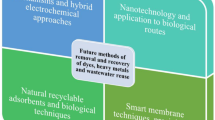
Overview
- Highlights recent findings of membrane and photocatalytic-based dye removal methods from wastewater
- Presents membrane separation technology that has been developed in the past decade to treat different wastewaters
- Includes materials such as ceramic, chitosan, lignin, and polyethersulfone and their applications in dye removal
Part of the book series: Sustainable Textiles: Production, Processing, Manufacturing & Chemistry (STPPMC)
Access this book
Tax calculation will be finalised at checkout
Other ways to access
About this book
This book highlights recent findings of membrane - based dye removal methods along with the application of photocatalytic, nanofiltration and ultrafiltration membrane including membrane – based fibers, metal-organic frameworks, polyethersulfone, ceramic, etc. Among water and wastewater pollutants, dyes have been normally observed and detected in various aquatic solutions, including rivers and lakes. Aesthetic pollution, toxicity, persistent, and carcinogenicity are some of the adverse effects of dyes entering the ecosystem. Although dyes have brought a colourful world, their presence in the environment are responsible for adverse effects on the planet. Diverse physical, chemical and biological methods are available to treat dye contaminated water. This book presents membrane separation technology that has been developed in the past decade to treat different wastewaters, and owning to its effective performance, has garnered the attention of academia and industry alike.
Similar content being viewed by others
Keywords
- Dye Removal
- Ultrafiltration Membrane Technology
- Photocatalytic Membrane
- Fibrous Membranes
- Lignin-based Membrane
- Chitosan-based Nanocomposite
- Metal-organic Membranes
- Textile Dyes
- Polyethersulfone
- Dye Pollution
- Water Purification/Treatment
- Ceramic Nanocomposite
- Effluent Wastewaters
- Dye Elimination
- Nanofiltration Membrane
Table of contents (11 chapters)
-
Front Matter
Editors and Affiliations
About the editors
Dr. Subramanian Senthilkannan Muthu currently works for SgT Group as Head of Sustainability, and is based out of Hong Kong. He earned his PhD from The Hong Kong Polytechnic University, and is a renowned expert in the areas of Environmental Sustainability in Textiles & Clothing Supply Chain, Product Life Cycle Assessment (LCA) and Product Carbon Footprint Assessment (PCF) in various industrial sectors. He has five years of industrial experience in textile manufacturing, research and development and textile testing and over a decade's of experience in life cycle assessment (LCA), carbon and ecological footprints assessment of various consumer products. He has published more than 100 research publications, written numerous book chapters and authored/edited over 100 books in the areas of Carbon Footprint, Recycling, Environmental Assessment and Environmental Sustainability.
Ali Khadir is an environmental engineer and a member of the Young Researcher and Elite Club, Islamic Azad University of Shahre Rey Branch, Tehran, Iran. He has published/prepared several articles and book chapters in reputed international publishers, including Elsevier, Springer, Taylor & Francis and Wiley. His articles have been published in journals with IF greater than 4, including Journal of Environmental Chemical Engineering and International Journal of Biological Macromolecules. He also has been the reviewer of journals and international conferences. His research interests center on emerging pollutants, dyes and pharmaceuticals in aquatic media, advanced water and wastewater remediation techniques and technology. At present, he is editing other books in the field of nanocomposites, advanced materials, and the remediation of dye – containing wastewaters.
Bibliographic Information
Book Title: Membrane Based Methods for Dye Containing Wastewater
Book Subtitle: Recent Advances
Editors: Subramanian Senthilkannan Muthu, Ali Khadir
Series Title: Sustainable Textiles: Production, Processing, Manufacturing & Chemistry
DOI: https://doi.org/10.1007/978-981-16-4823-6
Publisher: Springer Singapore
eBook Packages: Chemistry and Materials Science, Chemistry and Material Science (R0)
Copyright Information: The Editor(s) (if applicable) and The Author(s), under exclusive license to Springer Nature Singapore Pte Ltd. 2022
Hardcover ISBN: 978-981-16-4822-9Published: 15 October 2021
Softcover ISBN: 978-981-16-4825-0Published: 15 October 2022
eBook ISBN: 978-981-16-4823-6Published: 13 October 2021
Series ISSN: 2662-7108
Series E-ISSN: 2662-7116
Edition Number: 1
Number of Pages: VII, 303
Number of Illustrations: 38 b/w illustrations, 73 illustrations in colour
Topics: Structural Materials, Green Chemistry, Sustainable Development, Waste Management/Waste Technology, Environmental Chemistry



